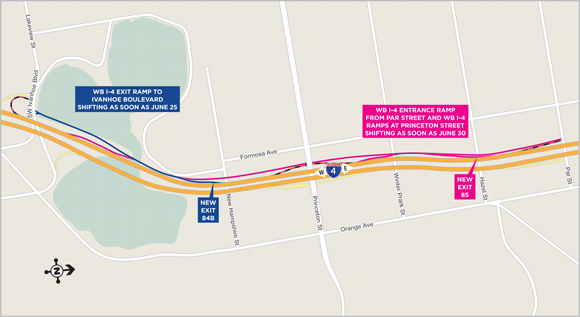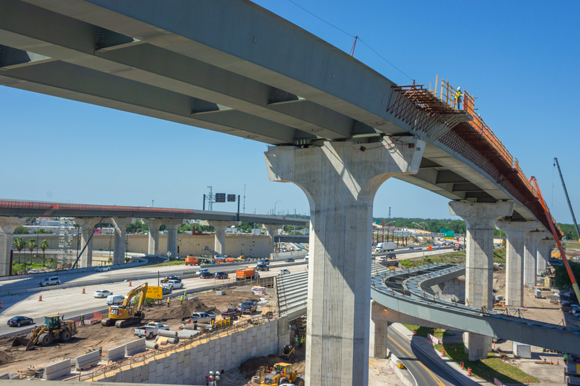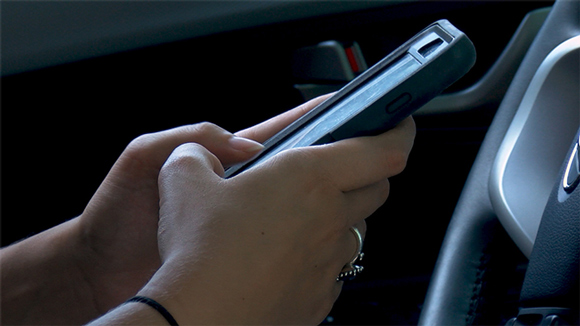The first permanent westbound Interstate 4 (I-4) bridges over Lake Ivanhoe are scheduled to open in the next month. These new bridges will support a redesigned westbound Interstate 4 (I-4) exit ramp to Ivanhoe Boulevard (Exit 84B). The exit point for the ramp will be located just above New Hampshire Street and before Lake Ivanhoe - about one half-mile sooner than before. The existing loop ramp will be replaced with a straight two-lane ramp. While not in its permanent configuration, this temporary ramp shift gives a glimpse at the future alignment of the Ivanhoe Boulevard exit ramp. Following this exit ramp shift at Ivanhoe Boulevard, the westbound I-4 ramps at Princeton Street and the westbound I-4 entrance ramp from Par Street also will move to interim configurations as soon as July to create two temporary ramp systems. The westbound I‑4 exit point for Princeton Street also will be shifted nearly one-half mile sooner. Motorists entering westbound I-4 from the Princeton Street and Par Street interchanges via the temporary ramp systems should be attentive to motorists exiting to Ivanhoe Boulevard and Princeton Street. The additional shifts are necessary to continue building the new westbound I‑4 travel lanes. Stay up to date to on all construction closures and detours by subscribing to the I‑4 Ultimate project advance construction alert system, Twitter feed or website newsfeed at i4ultimate.com/signup. |
The intricately planned effort to reconfigure, enlarge and improve the interchange of Interstate 4 (I-4) and State Road (S.R.) 408 in downtown Orlando has reached an important milestone. During a recent nighttime operation, crane operators set in place the last of 334 tub girder segments, marking an important moment of progress for the busiest interchange in the 21-mile I-4 Ultimate project. Tub girders are large U-shaped support beams used for support under elevated roadways. Work continues on the complex interchange, but motorists and residents should realize that the “skeleton” of the flyovers is now in place. Crews set in place a total of 2.2 miles of tub girders to support the effort. Some of those 334 tub girders were hoisted up to the tallest pier on the project. It sits 120 feet above ground and now supports a flyover ramp near the intersection of Division Avenue and Carter Street – one of many improvements to the interchange in the heart of Orlando. The construction team’s goal is to have the ramps in service by the middle of next year. To meet that goal, work continues both day and night, including pouring more concrete, installing barrier walls, and smoothing and grooving the concrete surface so it drains properly and offers good traction. |
Delegates from Paraguay visited Central Florida in June to learn more about I-4 Ultimate and the multi-faceted approach to funding a large infrastructure project. The 11 visitors, who primarily worked for Paraguay’s Ministry of Finance and the Ministry of Public Works and Communications, traveled to the United States through the International Visitor Leadership Program, a professional exchange program of the U.S. Department of State. This visit focused on infrastructure development and delivery, with the objectives of examining financial and decision-making transparency in large infrastructure projects, investigating the construction contracting process, and developing contacts with U.S. infrastructure companies. The presentation began with a video detailing all the planned improvements for the 15 interchanges along the 21 miles of I-4 being reconstructed, followed by a presentation of quick facts about the project, artistic renderings, and the methods used to keep the public informed about construction activity. Paul Wabi, P.E., who is the I-4 Ultimate Construction Program Manager for the Florida Department of Transportation (FDOT), gave a presentation that dived deeper into aspects of simultaneously designing and building a large infrastructure project. Wabi also gave a broader look at The Wekiva Parkway (State Road 429), which, when completed, will connect to State Road 417 and complete the beltway around Central Florida. After the presentations, delegates asked questions about the projects, and they were especially interested in the design-build aspect of the project, how the project was funded, and FDOT’s Small Business Enterprise (SBE) and Disadvantaged Business Enterprise (DBE) programs that ensure small businesses and businesses owned by women and minority groups can compete fairly for federally-funded projects. Before departing, the delegation thanked the I-4 Ultimate team for the information it shared, and they presented a small etched gift from Paraguay to commemorate the visit, which was displayed in the I-4 Ultimate hub office in Maitland. |
|
More Information |
|||||||||||
|---|---|---|---|---|---|---|---|---|---|---|---|
|
|
|
|||||||||
|
Contact us or Request a Speaker
|
|||||||||||
|
|
||||||
|---|---|---|---|---|---|---|---|
|
|||||||









